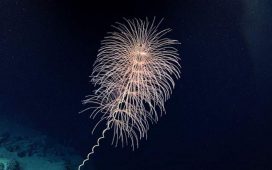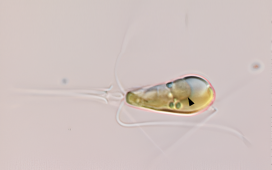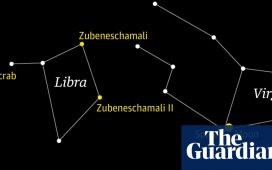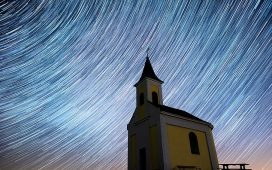
The world’s oldest parasite DNA has been discovered in the dried-out faeces of a prehistoric puma that roamed Argentina’s mountains during the last Ice Age.
The 17,000-year-old faeces was found in an inhospitable cave in the Catamarca Province in the northwest of the country. The eggs belonged to a species of roundworm called Toxascaris leonina which is still commonly found in the digestive systems of modern day cats, dogs and foxes.
It’s rare to find DNA this old as it usually gets damaged over time but dry, salty and cold conditions inside the cave preserved the specimen.
“While we have found evidence of parasites in coprolites before, those remains were much more recent, dating back only a few thousand years,” said Dr Romina Petrigh from Argentina’s National Council of Scientific and Technical Research (Conicet).
“The latest find shows that these roundworms were infecting the fauna of South America before the arrival of the first humans in the area around 11,000 years ago.
1/25 A polar bear’s struggle – Highly Commended
Justin Hofman, USA.
Justin’s whole body pained as he watched this starving polar bear at an abandoned hunter’s camp, in the Canadian Arctic, slowly heave itself up to standing. With little, and thinning, ice to move around on, the bear is unable to search for food.
Justin Hofman / Natural History Museum
2/25 Curious Encounter – Shortlisted
Cristobal Serrano, Spain. Any close encounter with an animal in the vast wilderness of Antarctica happens by chance, so Cristobal was thrilled by this spontaneous meeting with a crabeater seal off of Cuverville Island, Antarctic Peninsula. These curious creatures are protected and, with few predators, thrive.
Cristobal Serrano / Natural History Museum
3/25 Bond of brothers – Winner
David Lloyd, New Zealand / UK.
These two adult males, probably brothers, greeted and rubbed faces for 30 seconds before settling down. Most people never have the opportunity to witness such animal sentience, and David was honoured to have experienced and captured such a moment.The picture was taken in Ndutu, Serengeti, Tanzania.
David Lloyd / Natural History Museum
4/25 Fox meets fox – Highly Commended
Matthew Maran, UK.
Matthew has been photographing foxes close to his home in north London for over a year and ever since spotting this street art had dreamt of capturing this image. After countless hours and many failed attempts his persistence paid off.
Matthew Maran / Natural History Museum
5/25 Three Kings – Highly Commended
Wim Van Den Heever, South Africa.
Wim came across these king penguins on a beach in the Falkland Islands just as the sun was rising. They were caught up in a fascinating mating behaviour –the two males were constantly moving around the female using their flippers to fend the other off.
Wim Van Den Heever / Natural History Museum
6/25 One toy, three dogs – Highly Commended
Bence Mate, Hungary.
While adult African wild dogs are merciless killers, their pups are extremely cute and play all day long. Bence photographed these brothers in Mkuze, South Africa –they all wanted to play with the leg of an impala and were trying to drag it in three different directions!
Bence Mate / Natural History Museum
7/25 Clam Close-up – Shortlisted
David Barrio, Spain. This macro-shot of an iridescent clam was taken in the Southern Red Sea, Marsa Alam, Egypt. These clams spend their lives embedded amongst stony corals, where they nest and grow. It took David some time to approach the clam, fearing it would sense his movements and snap shut!
David Barrio / Natural History Museum
8/25 The Orphaned Beaver – Shortlisted
Suzi Eszterhas, United States. A one-month-old orphaned North American beaver kit is held by a caretaker at the Sarvey Wildlife Care Center in Arlington, Washington. Luckily it was paired with a female beaver who took on the role of mother and they were later released into the wild.
Suzi Eszterhas / Natural History Museum
9/25 Ice and Water – Shortlisted
Audun Lie Dahl, Norway. The Bråsvellbreen glacier moves southwards from one of the ice caps covering the Svalbard Archipelago, Norway. Where it meets the sea, the glacier wall is so high that only the waterfalls are visible, so Audun used a drone to capture this unique perspective
Audun Lie Dahl / Natural History Museum
10/25 Teenager – Shortlisted
Franco Banfi, Switzerland. Franco was free diving off Dominica in the Caribbean Sea when he witnessed this young male sperm whale trying to copulate with a female. Unfortunately for him her calf was always in the way and the frisky male had to continually chase off the troublesome calf.
Franco Banfi / Natural History Museum
11/25 Resting Mountain Gorilla – Shortlisted
David Lloyd. The baby gorilla clung to its mother whilst keeping a curious eye on David. He had been trekking in South Bwindi, Uganda, whenhe came across the whole family. Following them, they then stopped in a small clearing to relax and groom each other.
David Lloyd / Natural History Museum
12/25 Painted Waterfall – Shorltisted
Eduardo Blanco Mendizabal, Spain. When the sun beams through a hole in the rock at the foot of the La Foradada waterfall, Catalonia, Spain, it creates a beautiful pool of light. The rays appear to paint the spray of the waterfall and create a truly magical picture.
Eduardo Blanco Mendizabal / Natural History Museum
13/25 The Extraction – Shortlisted
Konstantin Shatenev, Russia. Every winter, hundreds of Steller’s sea eagles migrate from Russia, to the relatively ice-free northeastern coast of Hokkaido, Japan. They hunt for fish among the ices floes and also scavenge, following the fishing boats to feed on any discards. Konstantin took his image from a boat as the eagles retrieved a dead fish thrown onto the ice.
Konstantin Shatenev / Natural History Museum
14/25 Shy – Shortlisted
Pedro Carrillo, Spain. The mesmerizing pattern of a beaded sand anemone beautifully frames a juvenile Clarkii clownfish in Lembehstrait, Sulawesi, Indonesia. Known as a ‘nursery’ anemone, it is often a temporary home for young clownfish until they find a more suitable host anemone for adulthood.
Pedro Carrillo / Natural History Museum
15/25 Red, Silver and Black – Shortlisted
TinMan Lee, USA. Tin was fortunate enough to be told about a fox den in Washington State, North America, which was home to a family of red, black and silver foxes. After days of waiting for good weather he was finally rewarded with this touching moment.
Tin Man Lee / Natural History Museum
16/25 Isolated – Shortlisted
Anna Henly, UK. Snapped from a helicopter, this isolated tree stands in a cultivated field on the edge of a tropical forest on Kauai, Hawaii. The manmade straight lines of the ploughed furrows are interrupted beautifully by nature’s more unruly wild pattern of tree branches.
Anna Henly / Natural History Museum
17/25 Sound Asleep – Shortlisted
Tony Wu, USA. This adult humpback whale balanced in mid-water, headon and sound asleep was photographed in Vava’u, Kingdom of Tonga. The faint stream of bubbles, visible at the top, is coming from the whale’s two blowholes and was, in this instance, indicative of an extremely relaxed state.
Tony Wu / Natural History Museum
18/25 All That Remains – Shortlisted
Phil Jones, UK. A male orca had beached itself about a week before Phil’s visit to Sea Lion Island, Falkland Islands. Despite its huge size the shifting sands had almost covered the whole carcass and scavengers, such as this striated caracara, had started to move in.
Phil Jones / Natural History Museum
19/25 Ambush – Shortlisted
Federico Veronesi, Kenya. On a hot morning at the Chitake Springs, in Mana Pools National Park, Zimbabwe, Federico watched as an old lioness descended from the top of the riverbank. She’d been lying in wait to ambush any passing animals visiting a nearby waterhole further along the riverbed.
Federico Veronesi / Natural History Museum
20/25 Gliding – Shortlisted
Christian Vizl, Mexico. With conditions of perfect visibility and beautiful sunlight, Christian took this portrait of a nurse shark gliding through the ocean off the coast of Bimini in the Bahamas. Typically these sharks are found near sandy bottoms where they rest, so it’s rare to see them swimming.
Christian Vizl / Natural History Museum
21/25 Otherworldly – Shortlisted
Franco Banfi, Switzerland. A school of Munk’s devil ray were feeding on plankton at night off the coast of Isla Espíritu Santo in Baja California, Mexico. Franco used the underwater lights from his boat and a long exposure to create this otherworldly image.
Franco Banfi / Natural History Museum
22/25 The Bat’s Wake – Shortlisted
Antonio Leiva Sanchez, Spain. After several months of field research into a little colony of greater mouse-eared bats in Sucs, Lleida, Spain, Antonio managed to capture this bat mid-flight. He used a technique of high speed photography with flashes combined with continuous light to create the ‘wake’.
Antonio Leiva Sanchez / Natural History Museum
23/25 Under the Snow – Shortlisted
Audren Morel, France. Unafraid of the snowy blizzard, this squirrel came to visit Audren as he was taking photographs of birds in the small Jura village of Les Fourgs, France. Impressed by the squirrel’s endurance, he made it the subject of the shoot.
Audren Morel / Natural History Museum
24/25 Unique Bill – Shortlisted
Rob Blanken, The Netherlands. The pied avocet has a unique and delicate bill, which it sweeps like a scythe, as it sifts for food in shallow brackish water. This stunning portrait was taken from a hide in the northern province of Friesland in The Netherlands.
Rob Blanken / Natural History Museum
25/25 Family Portrait – Shortlisted
Connor Stefanison, Canada. A great grey owl and her chicks sit in their nest in the broken top of a Douglas fir tree in Kamloops, Canada. They looked towards Connor only twice as he watched them during the nesting season from a tree hide 50 feet (15 metres) up.
Connor Stefanison / Natural History Museum
1/25 A polar bear’s struggle – Highly Commended
Justin Hofman, USA.
Justin’s whole body pained as he watched this starving polar bear at an abandoned hunter’s camp, in the Canadian Arctic, slowly heave itself up to standing. With little, and thinning, ice to move around on, the bear is unable to search for food.
Justin Hofman / Natural History Museum
2/25 Curious Encounter – Shortlisted
Cristobal Serrano, Spain. Any close encounter with an animal in the vast wilderness of Antarctica happens by chance, so Cristobal was thrilled by this spontaneous meeting with a crabeater seal off of Cuverville Island, Antarctic Peninsula. These curious creatures are protected and, with few predators, thrive.
Cristobal Serrano / Natural History Museum
3/25 Bond of brothers – Winner
David Lloyd, New Zealand / UK.
These two adult males, probably brothers, greeted and rubbed faces for 30 seconds before settling down. Most people never have the opportunity to witness such animal sentience, and David was honoured to have experienced and captured such a moment.The picture was taken in Ndutu, Serengeti, Tanzania.
David Lloyd / Natural History Museum
4/25 Fox meets fox – Highly Commended
Matthew Maran, UK.
Matthew has been photographing foxes close to his home in north London for over a year and ever since spotting this street art had dreamt of capturing this image. After countless hours and many failed attempts his persistence paid off.
Matthew Maran / Natural History Museum
5/25 Three Kings – Highly Commended
Wim Van Den Heever, South Africa.
Wim came across these king penguins on a beach in the Falkland Islands just as the sun was rising. They were caught up in a fascinating mating behaviour –the two males were constantly moving around the female using their flippers to fend the other off.
Wim Van Den Heever / Natural History Museum
6/25 One toy, three dogs – Highly Commended
Bence Mate, Hungary.
While adult African wild dogs are merciless killers, their pups are extremely cute and play all day long. Bence photographed these brothers in Mkuze, South Africa –they all wanted to play with the leg of an impala and were trying to drag it in three different directions!
Bence Mate / Natural History Museum
7/25 Clam Close-up – Shortlisted
David Barrio, Spain. This macro-shot of an iridescent clam was taken in the Southern Red Sea, Marsa Alam, Egypt. These clams spend their lives embedded amongst stony corals, where they nest and grow. It took David some time to approach the clam, fearing it would sense his movements and snap shut!
David Barrio / Natural History Museum
8/25 The Orphaned Beaver – Shortlisted
Suzi Eszterhas, United States. A one-month-old orphaned North American beaver kit is held by a caretaker at the Sarvey Wildlife Care Center in Arlington, Washington. Luckily it was paired with a female beaver who took on the role of mother and they were later released into the wild.
Suzi Eszterhas / Natural History Museum
9/25 Ice and Water – Shortlisted
Audun Lie Dahl, Norway. The Bråsvellbreen glacier moves southwards from one of the ice caps covering the Svalbard Archipelago, Norway. Where it meets the sea, the glacier wall is so high that only the waterfalls are visible, so Audun used a drone to capture this unique perspective
Audun Lie Dahl / Natural History Museum
10/25 Teenager – Shortlisted
Franco Banfi, Switzerland. Franco was free diving off Dominica in the Caribbean Sea when he witnessed this young male sperm whale trying to copulate with a female. Unfortunately for him her calf was always in the way and the frisky male had to continually chase off the troublesome calf.
Franco Banfi / Natural History Museum
11/25 Resting Mountain Gorilla – Shortlisted
David Lloyd. The baby gorilla clung to its mother whilst keeping a curious eye on David. He had been trekking in South Bwindi, Uganda, whenhe came across the whole family. Following them, they then stopped in a small clearing to relax and groom each other.
David Lloyd / Natural History Museum
12/25 Painted Waterfall – Shorltisted
Eduardo Blanco Mendizabal, Spain. When the sun beams through a hole in the rock at the foot of the La Foradada waterfall, Catalonia, Spain, it creates a beautiful pool of light. The rays appear to paint the spray of the waterfall and create a truly magical picture.
Eduardo Blanco Mendizabal / Natural History Museum
13/25 The Extraction – Shortlisted
Konstantin Shatenev, Russia. Every winter, hundreds of Steller’s sea eagles migrate from Russia, to the relatively ice-free northeastern coast of Hokkaido, Japan. They hunt for fish among the ices floes and also scavenge, following the fishing boats to feed on any discards. Konstantin took his image from a boat as the eagles retrieved a dead fish thrown onto the ice.
Konstantin Shatenev / Natural History Museum
14/25 Shy – Shortlisted
Pedro Carrillo, Spain. The mesmerizing pattern of a beaded sand anemone beautifully frames a juvenile Clarkii clownfish in Lembehstrait, Sulawesi, Indonesia. Known as a ‘nursery’ anemone, it is often a temporary home for young clownfish until they find a more suitable host anemone for adulthood.
Pedro Carrillo / Natural History Museum
15/25 Red, Silver and Black – Shortlisted
TinMan Lee, USA. Tin was fortunate enough to be told about a fox den in Washington State, North America, which was home to a family of red, black and silver foxes. After days of waiting for good weather he was finally rewarded with this touching moment.
Tin Man Lee / Natural History Museum
16/25 Isolated – Shortlisted
Anna Henly, UK. Snapped from a helicopter, this isolated tree stands in a cultivated field on the edge of a tropical forest on Kauai, Hawaii. The manmade straight lines of the ploughed furrows are interrupted beautifully by nature’s more unruly wild pattern of tree branches.
Anna Henly / Natural History Museum
17/25 Sound Asleep – Shortlisted
Tony Wu, USA. This adult humpback whale balanced in mid-water, headon and sound asleep was photographed in Vava’u, Kingdom of Tonga. The faint stream of bubbles, visible at the top, is coming from the whale’s two blowholes and was, in this instance, indicative of an extremely relaxed state.
Tony Wu / Natural History Museum
18/25 All That Remains – Shortlisted
Phil Jones, UK. A male orca had beached itself about a week before Phil’s visit to Sea Lion Island, Falkland Islands. Despite its huge size the shifting sands had almost covered the whole carcass and scavengers, such as this striated caracara, had started to move in.
Phil Jones / Natural History Museum
19/25 Ambush – Shortlisted
Federico Veronesi, Kenya. On a hot morning at the Chitake Springs, in Mana Pools National Park, Zimbabwe, Federico watched as an old lioness descended from the top of the riverbank. She’d been lying in wait to ambush any passing animals visiting a nearby waterhole further along the riverbed.
Federico Veronesi / Natural History Museum
20/25 Gliding – Shortlisted
Christian Vizl, Mexico. With conditions of perfect visibility and beautiful sunlight, Christian took this portrait of a nurse shark gliding through the ocean off the coast of Bimini in the Bahamas. Typically these sharks are found near sandy bottoms where they rest, so it’s rare to see them swimming.
Christian Vizl / Natural History Museum
21/25 Otherworldly – Shortlisted
Franco Banfi, Switzerland. A school of Munk’s devil ray were feeding on plankton at night off the coast of Isla Espíritu Santo in Baja California, Mexico. Franco used the underwater lights from his boat and a long exposure to create this otherworldly image.
Franco Banfi / Natural History Museum
22/25 The Bat’s Wake – Shortlisted
Antonio Leiva Sanchez, Spain. After several months of field research into a little colony of greater mouse-eared bats in Sucs, Lleida, Spain, Antonio managed to capture this bat mid-flight. He used a technique of high speed photography with flashes combined with continuous light to create the ‘wake’.
Antonio Leiva Sanchez / Natural History Museum
23/25 Under the Snow – Shortlisted
Audren Morel, France. Unafraid of the snowy blizzard, this squirrel came to visit Audren as he was taking photographs of birds in the small Jura village of Les Fourgs, France. Impressed by the squirrel’s endurance, he made it the subject of the shoot.
Audren Morel / Natural History Museum
24/25 Unique Bill – Shortlisted
Rob Blanken, The Netherlands. The pied avocet has a unique and delicate bill, which it sweeps like a scythe, as it sifts for food in shallow brackish water. This stunning portrait was taken from a hide in the northern province of Friesland in The Netherlands.
Rob Blanken / Natural History Museum
25/25 Family Portrait – Shortlisted
Connor Stefanison, Canada. A great grey owl and her chicks sit in their nest in the broken top of a Douglas fir tree in Kamloops, Canada. They looked towards Connor only twice as he watched them during the nesting season from a tree hide 50 feet (15 metres) up.
Connor Stefanison / Natural History Museum
“I was very happy when I discovered how old this DNA was. It is difficult to recover DNA of such an old age as it usually suffers damage over time,” she said.
Life in the region would have been very different when the puma was alive – it was much wetter and humans had not arrived yet.
The giant cat probably hunted stilt legged horses and the ancestors of modern-day camels, known as camelids. The region was also home to giant sloths, sabre-toothed cats and wolves.
The study, published in the journal Parasitology, shows that roundworm – which is picked up by humans in contaminated soil and results in a rash, headaches and diarrhoea – was around long before humans came to the region.
Archaeologists think cases of parasitic disease increased among humans as hunter-gatherer populations became settled farmers. This would have put them in regular contact with accumulated waste and excrement, making the infections more likely.
“The common interpretation is that the presence of T. leonina in American wild carnivores today is a consequence of their contact with domestic dogs or cats, but that should no longer be assumed as the only possible explanation,” said Dr Petrigh.
The study also shows that pumas were in southern Puna at the end of the Pleistocene.
“This has significant implications for the natural history of the region, as well as for inferring the ecological context immediately before – as far as is known – the first human explorers ventured into the area,” said Dr Petrigh.
“The large number of eggs of T. leonina and its larva state in the puma coprolite analysed here indicate the high infective capacity of this parasite, involving a high risk for carnivores and for humans.”.














